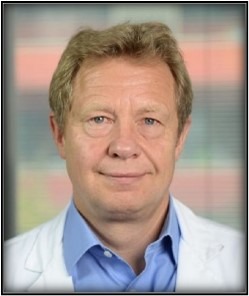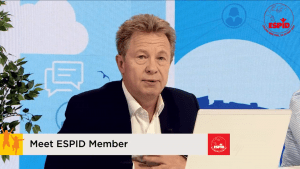Interview with Ulrich Heininger
We caught up with one of the ESPID 2021 co-chairs before the ESPID Show.
IN CONVERSATION WITH
PROF. ULRICH HEININGER

Prof. Ulrich Heininger, MD, Senior Physician Infectiology/ Vaccinology, Deputy Chief Physician, Research Group Leader, University Children’s Hospital Basel (UKBB), Switzerland. Expert in clinical, epidemiological, and molecular research with a focus on Bordetella infections (whooping cough).
Member of ESPID since 1993; Co-chair ESPID 2021 & ESPID 2006, Former President of ESPID 2009-2012.
After 15 years, you’ve again taken on the role of co-chairing an ESPID Meeting. What made you decide to do it again? Do you have any specific memories from your experience with ESPID 2006 that come to mind in preparation for ESPID 2021?
My colleague Nicole Ritz asked me to support organizing ESPID 2021 because of my experience as co-chair back in 2006. We invited Klara Posfay-Barbe to join us forming a team of three. Fifteen years ago, I was the junior co-chair supported by Urs Schaad who had organized an ESPID Meeting in Switzerland in 1984. Now I find myself the senior member of the team, advising the others.
Is the senior role a bit more relaxed?
(Laughs) I wish it were. It’s still a lot of work.
As for my memories from ESPID 2006, two things really stand out. First of all, I was truly amazed by the amount of preparation that goes into organizing a conference of such magnitude. It was a tremendous undertaking and a great learning experience for me. My interaction with colleagues from around the world improved, and I became adept at persuading busy colleagues to agree to speak at the conference.
I was truly amazed by the amount of preparation that goes into organizing a conference of such magnitude. It was a tremendous undertaking and a great learning experience for me. My interaction with colleagues from around the world improved, and I became adept at persuading busy colleagues to agree to speak at the conference.
I also have pleasant memories the of the social occasions of the 2006 conference, such as the speaker’s dinner and the farewell event, which included nice conversations, a good glass of wine, live music, and dancing. Having some fun together socially strengthens professional relationships, it’s like team building.
How would you compare the effort involved in pulling this year’s Online Meeting together compared to the face-to-face meeting 15 years ago? Has it been more work, less work, or just a different type of work?
A virtual conference is definitely more work and work of a different sort. In 2006, there were two steps; prepare and present (live). Now we have four steps: prepare, record, watch (your pre-recorded talk) and discuss. The same is true for chairing sessions, which sometimes require multiple rehearsals to go over techniques for moderation, Q&A and so on. Changing technology brings improvements but also requires instruction.
ESPID Meeting attendance has NEARLY DOUBLED from 1700 in 2006 to over 3000 this year. How does that growth affect conference planning to maintain high levels of participant involvement, opportunity for networking, and knowledge exchange?
It doesn’t have much impact on the planning actually, except that more attendees mean a higher volume of abstracts which need to be carefully evaluated, which takes a great deal of time.
Can you mention any big changes to ESPID Meetings that come to mind?
One thing that has definitely changed is the introduction of electronic posters (e-posters). Back in 2006, we had paper posters of course, and we took ‘poster walks,’ with the author standing next to their poster, ready to meet you and talk about his/her work. I liked meeting people that way, it facilitates collaboration. Mobile phones were not so sophisticated back then, so if you really liked a poster, you took a photo of it with your camera.
Another benefit of today’s technology is the ability to review participants’ questions in real time, and select the most relevant ones to respond to during the Q&A. At live sessions this wasn’t possible of course – whoever was called on got the floor, whether or not their question or comment was interesting to other participants. The way we do it now enhances the quality of the sessions.
At physical conferences one moves from room-to-room, meeting colleagues along the way that perhaps you haven’t seen for a couple of years. You might fall into a conversation that may even cause you to miss the session to which you were heading. But that’s okay, back then some sessions were also recorded so we could listen to them later. Now we move from one session to the next via a mouse click, which saves time. However, I do look forward to seeing my colleagues face-to-face again once the constraints of the pandemic have passed.
You seem to wear many hats: Professor, clinical researcher, epidemiological expert, bedside PID expert. Which hat do you wear most? Which hat do you like the best?
I like all of my hats, and I like to change them regularly, just like my shirts. My time is spread fairly evenly between patient care, teaching (bedside teaching, mentoring students, and giving lectures) and clinical research.
The fourth hat I wear is public health policymaking. I serve on the STIKO, the NITAG (National Immunization Technical Advisory Group) which provides immunization recommendations to the German government. I’ve served on this committee for 20 years now, and it has never been so busy as we’ve experienced in the last 12 months. This is a tremendous responsibility that absorbs a great deal of time.
I like the diversity of the roles I play in my work. If I had to give up one of these tasks, I don’t know which one I would choose, because they all matter to me.
How would you assess the amount of progress that has been made over the last 15 years in your own field of research on vaccine-preventable diseases, vaccines, and vaccine safety?
I am very pleased to say that there has been significant progress in the development of safe and effective vaccines. We have more vaccines today than we had in 2006, and there are more successful vaccination programs in the world. Take HPV for example, which came onto the market, and also the widened use of pertussis vaccines. As a founder of the Brighton Collaboration, which develops case definitions of adverse vaccine-related events, I believe we have become better able to show evidence-based progress in vaccine safety over the last 15 years. We’ve found better ways to counteract vaccine hesitancy as well, and it seems like public confidence has risen. Last but not least is the unprecedented pace and efficiency at which the COVID vaccines have been developed. This is unheard of in human history.
How has the COVID pandemic impacted your research in vaccine-preventable diseases over the last year? Has it created obstacles or slowed progress?
Absolutely. Our normal research on Pertussis (whooping cough) was sidelined and managing the COVID pandemic became the top priority. My team shifted over to specializing in various aspects of COVID – while mine is vaccines, other members of my team deal with research of clinical presentation, treatment, hygiene and epidemiology. We long to take up our normal work again. The lockdown has reduced the number of instances of whooping cough, but it will come back again once the pandemic is over.
Is whooping cough still a big problem?
It is, and there are new issues to research, like the effect of immunizing pregnant women for example. Very interesting.
Has COVID triggered anything positive?
In the western world, there is no doubt that COVID has raised public awareness about the value of immunization to protect our health. However, it’s probably a ‘honeymoon’ period. I anticipate that in a few months’ time the discussion will sour, as people who refuse to get vaccinated might be blamed for any ongoing troubles we might encounter in bringing the coronavirus under control.
What about on the supply side? Increased vaccine production capacity?
Indeed. A new era of vaccines has begun. Once COVID has run its course and demand has abated, much of the recently built infrastructure can be used to produce other useful vaccines. In the future we may see fewer shortages, and the process innovation that came with COVID can be replicated to fight other infectious agents with cheaper, effective vaccines.
Do you think the fun factor is still there at a virtual conference?
Yes, but it’s in a different form. There are quizzes, an evening show, the talk show, and so on. We need informal moments and breaks from the science to relax and catch our breath. My feeling is that while chat room interaction and networking far better than not meeting at all, personally I look forward (to?) the time when I can meet colleagues face-to-face again for a coffee and a good chat. Those days will return.
Beyond the obvious goals of great attendance and participation, what are your measures for a successful ESPID 2021?
If I receive positive feedback from my colleagues, that’s my measure. Whether it’s from colleagues I know well or people who are new to me, if they take the time to share what they liked (or didn’t like) about the conference, that means a great deal to me.
